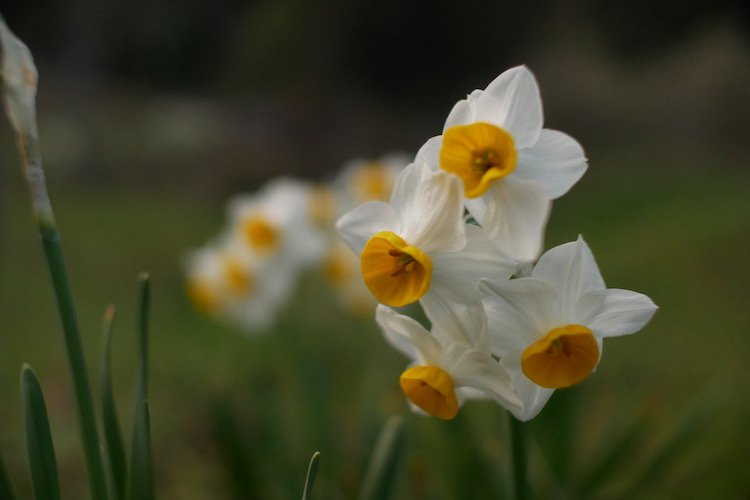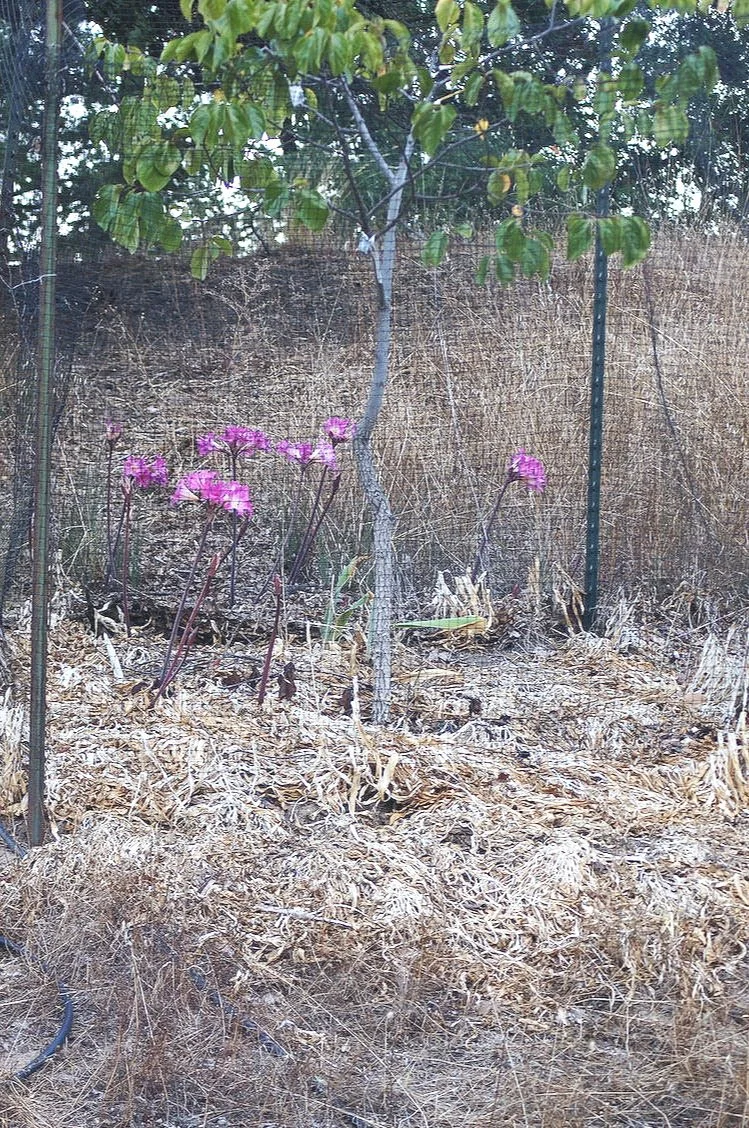WATER SAVING TREE UNDER STORIES FOR MEDITERRANEAN CLIMATES
Once upon a time, I noticed that a particular flower would grow dense foliage all winter and then die back completely before summer. The idea occurred to me to use this and similar plants as an understory for fruit trees in order to solve problems particular to my Dry summer mediterranean climate. I planted many tests using different plants to figure out what works best. Years later, I’m ready for phase two, which is applying this system to fruit trees in a more controlled way, to assess the effectiveness, feasibility and practicality in real life.
It’s important to understand the context here. it is very commonly recommended to plant various things under fruit trees. Under stories, and what are usually called plant guilds, are a staple of permaculture theory and design. Most of the recommendations I’ve seen are for areas with high rainfall or other soil moisture in the growing season, but don’t account for water competition in areas where that factor is a major shaping force of plant growth. Here it does not rain in the summer. On the rare occasion that it does, it is not enough to matter to plant growth and certainly not deep rooted perennials. There are many areas of the world where this kind of weather pattern is a reality, but which otherwise, are excellent for agriculture. In dry summer climates, competition for water can really be a big deal. If I planted most of the deep rooted plants that people commonly recommend to plant under fruit trees, they would be in competition for that scarce water all summer. The go to is usually comfrey. I know what comfrey does here. It tries to grow all summer, even under heavy wilt and will strive to continue to find and use water. In lieu of irrigation, that kind of plant is not the best choice under a tree that is also trying to eek out a living on minimal water. This is a good example of why cookie cutter permaculture will often not work. Permaculture should be about working with the resources and patterns of a specific place to create smart designs that adapt to those circumstances.
But I do want cover under my fruit trees to shade the soil. If I can use a ground cover to out compete grass and annuals, but does not compete with the tree in the dry season, that is a double benefit. Enter a small narcissus Daffodil called Chinese Sacred Lily.
The Chinese Sacred Lily
I noticed on old homestead sites that you can find these little daffodils growing in dense thickets. They may have been planted 100 or more years ago. I planted some here, because I’ve always liked them, and also noticed that they would grow up early in winter, flower, and then die back long before the soil moisture was gone. They seem to be on their own timer. Even if water is still available, the leaves become brown, and are usually flat on the ground by some time in May. I figured if I planted them under fruit trees thickly enough, maybe they would smother all the weeds and grass which otherwise would grow, and keep growing, until the water ran out in summer. Once dead, I hoped they would form a mulch on the ground for the summer. People often refer to low growing plant understories as “living mulch”, so I called my idea a “dying mulch”. I figured if it would work, it could be hugely beneficial.
The Chinese sacred lily was the first plant I used. Then I hunted down many other small and large daffodils/narcissus and planted them to see how they performed. It turned out that Chinese sacred lily was actually the best of the lot, though some others perform okay, notably Erlicheer. Chinese Sacred Lily grows earliest, has thick wide leaves and dies back early. I also started looking for other plants and asking friends what they might think of that would work. I tested various different plants, some of them bulbs, and others broad leafed plants. The best one turned out to be a flowering bulb, Amaryllis belladona, aka Naked Ladies, recommended by the late Bill the Bulb Baron, thanks Bill!
Once Amaryllis are established on about a 12 inch spacing, they smother all weeds and die back by about June 1st most years. They don’t die back as early as the Narcissus, but they are more vigorous, taller, broader leaved and as a result of all that, they outcompete everything else that tries to grow. Some years I’ll have a few weak thistles that manage to get their heads above the sea of green leaves and make it, but It’s pretty much complete domination. The mat of dead leaves is so thick that you can’t see the ground at all.
This is what a well established understory of Amaryllis looks like in the winter. Having the advantage of large bulbs to store resources, allows them to outgrow plants that have to start from seed. Grasses and forbs will keep growing as long as they can scrounge any water, while these are on a self timer and will wilt back even when there is still moisture in the soil. This tree has never grown well. In other spots, trees have grown better than the bulbs. So more plantings and experiments in management and observation of trees with and without understories are needed for long term observation.
Amaryllis understory in the summer. This is an old picture, it makes an even denser mat of dead leaves now. Early fall flowers have potential as a market crop. I’ve sold them at the farmer’s market, but I’m sure some florists would be interested.
So that was the proof of concept phase. If I can get the space I need, the next phase will involve more controlled trials. We need to know how much the bulb understory competes with the trees, or maybe more broadly and more relevant, do trees grow well with that thick understory. After all, water is not the only resource plants compete for. I have cultivated a lot of these bulbs and know where I can get a lot more. I have enough to plant tests underneath a sizable number of trees. But I also need control trees grown under the same conditions and treated the same in order to compare overall tree performance. The ideal scenario would be a small commercial orchard with alternate trees, blocks or rows with and without the understory. I have the bulbs, I know what to do, I want to grow the trees anyway, so now it’s just a matter of long term access to land and getting them in the ground. Like all of my tree and soil related projects, this is long term stuff. I probably need at least 8 or 10 years to get a really good picture of its practicality in real life farming. I’m determined not to undertake any long term experiments until I have a place I’m pretty sure I can stay at indefinitely. So this project is on hold until I get a new place.
This is a really neat system. It looks great in the winter with the thick head of juicy green leaves and tidy in the summer with a uniform mat of dead ones. In the early fall, from out of that dead mat of leaves, come long stalks with large, fragrant pink flowers that have potential as a cash crop. Aside from the usual common Amaryllis Belladona, aka naked ladies, there are also hybrids with different colored flowers. All in all, it looks promising, it’s just a matter of testing it in more real life situations, with controls.
Amaryllis hybrid. Flowers in hybrids can range from white through pink and salmon to red. I have found hybrids to be a little more cold sensitive. I’ve seen damage in low cold spots, with temps probably in the low 20’s, though they usually survive. Even the common pale pink Amaryllis belladonna aka Naked Ladies are not very hardy, so this plant will only work in mild winter areas. the hybrids probably have more potential as market flowers.
If anyone living in a Mediterranean climate wants to try it, I recommend planting the bulbs about 10 to 12 inches apart in every direction, out to the drip line of the tree if you can. The bulbs will more than triple in three years, so if you buy a few, they can be grown in a garden bed or similar situation to increase their numbers before planting under the trees. Amaryllis also don’t mind summer watering and do well with lots of fertilizer. If you can find them, buy “chips”, which are smaller inexpensive bulbs. You can also grow them from seed easily and the plants produce seed abundantly, though they take quite a while to size up and flower when grown from seed.



